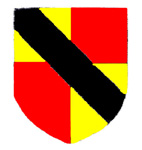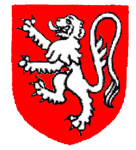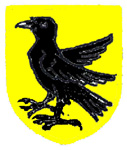Linslade Manors

Beauchamp coat of arms
Linslade Manor
Before 1086 Linslade was held by one Alwin, a man of Queen Edith. In 1086 the manor comprised fifteen hides and was held by Hugh de Beauchamp, later Baron of Bedford.
Simon de Beauchamp, possibly Hugh's great-grandson held the manor in the 12th century and made grants of land there. His son William succeeded him and granted half the manor to one Nichole Benet, however, the whole manor was still in possession of his son, William the younger before 1251, although the elder William did not die until 1260.
William the younger died just two years after his father and an inquest held that year resolved the problem of the ownership of the manor. Nichole Benet had demised her half of the estate to Newnham Priory, in Bedford, for her life, the prior then demising this interest to William the younger. William the younger's brother John succeeded to the manor but only held it for three years as he was killed at the Battle of Evesham in 1265 when King Henry III's forces destroyed the rebel barons led by Simon de Montfort. John and William's three sisters inherited their lands, Linslade falling to the eldest sister, Maud, although the other two sisters Beatrice and Ela also had minor land holdings in Linslade.

Mowbray coat of arms
Maud Beauchamp was married to Roger de Mowbray, who died around 1266, their son Roger being still a minor in 1278. Her second husband was Roger l'Estrange who held Linslade Manor from 1284 until his death in 1311, when the late Maud's grandson John de Mowbray succeeded him; he granted the manor to William de Braose in 1316 and was hanged by Edward II after fighting for the rebels at the Battle of Boroughbridge in 1322. John's son, also John, was restored to his lands in 1327 on the accession of Edward III and granted Linslade Manor to John de Leybourne for life in 1344. Shortly before his death in 1361 Mowbray settled the manor on himself and Elizabeth, his wife, for their lives, remainder to their son John. His widow later married Sir William de Cosynton and held Linslade until her death when her son John duly succeeded her until his death in 1368.
John de Mowbray's son, yet another John, was still a minor at the time of his father's death. He was created earl of Nottingham in 1377 and died in 1382, his heir being his brother Thomas, who was created Duke of Norfolk in 1397. He died in 1400 having granted Linslade Manor to trustees as part of his son Thomas' marriage settlement in 1392. Thomas died in 1405 and after the death of his widow Constance in 1437 overlordship of Linslade Manor passed to his nephew John, 5th Duke of Norfolk, who died in 1461. The 6th Duke of Norfolk held the manor until his death, without male heirs, in 1476. Thomas Earl of Arundel was acknowledged as overlord as late as 1637
The Dukes of Norfolk seem to have been transferred the manorial rights of Linslade early in the 15th century; certainly Sir Walter Lucy was tenant of the manor in 1433; his family had held land in Linslade under both the Beauchamp and Mowbray families since the 13th century. They also held the neighbouring manor of Nares Gladley. The manor and its rights remained in the Lucy family until 1498 when Elizabeth Lucy devised it to her grandson Sir Robert Corbet.

Corbet coat of arms
Sir Robert Corbet died in 1513 and the manor remained in the family until 1688. Sir Vincent Corbet, baronet, was an enthusiastic Royalist during the Civil Wars and he died in 1656. In 1679 King Charles II, on account of Vincent's support for the crown, created his widow Viscountess Corbet of Linslade. She was succeeded by her son and grandson; on the death of the latter in 1688, the baronetcy became extinct. The heir was Beatrice, wife of John Kynaston and she divided the Manor of Linslade with Richard Corbet, great-uncle of the last baronet and the manor reverted back to the Corbet family on her death. The Corbets ceased their 323 year association with Linslade Manor when they sold it in 1821 to William Pulsford; on his death it passed to his daughter Anne, wife of Sir William Goodenough Hayter, baronet and their son, created Lord Haversham in 1906 was Lord until successive laws of property acts in the 1920s ended all manorial privileges bar the title.
Other Significant Landowners in Linslade
As noted above Maud Mowbray received the bulk of the lands of Linslade Manor but her sisters Beatrice and Ela also received some. Beatrice's second husband, William de Monchesney was recorded as owning 72 acres in Linslade in the 1280s as well as a capital messuage, or manor house. This land eventually passed to John de Patishull, a descendent of Beatrice's sister Ela by 1346. Ela Mowbray married Sir Baldwin Wake and her eldest daughter inherited her three daughters each inherited some of her Linslade land. After the 14th century no further references to these land holdings can be traced.
Josselyn's Manor
This manor is first identified at the end of the 15th century when Sir Ralph Josselyn, Mayor of London had the manor. Josselyn died in 1478 and was succeeded by his nephew George. His widow Elizabeth married Sir Robert Clifford and she and her husband were sued in 1507 by her father William Barlee who claimed ownership of the manor. By 1538, however, the manor was in the hands of the Corbet family and became absorbed into Linslade Manor.

Old Linslade Manor October 2008